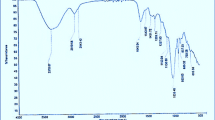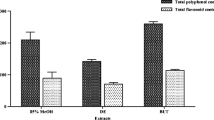Abstract
Crude extracts were prepared from fruiting bodies and mycelia of the medicinal fungus Cordyceps militaris, and a polysaccharide-enriched fraction was obtained after extraction with hot water and ethanol precipitation. Polysaccharide-enriched fractions were similarly prepared from Cordyceps sinensis, Omphalia lapidescens, and Tricholoma mongolicum. The various aforementioned preparations were orally administered into different groups of adult rats 24 h before an intraperitoneal injection of streptozotocin (40 mg/kg body weight), and subsequently daily for another 4 days. The dosage used was 10 mg/kg body weight for polysaccharide-enriched preparations and 100 mg/kg body weight for crude extracts. Control rats received distilled water instead of crude extract or polysaccharide-enriched preparation. It was found in the control rats that plasma glucose level rose from about 90 mg/dl before streptozotocin injection to levels that were maintained at about 300 mg/dl postinjection. All preparations produced hypoglycemic effects. C. militaris polysaccharide-enriched fraction displayed a more prominent effect than that of C. sinensis polysaccharide-enriched fraction which in turn was more potent than that of O. lapidescens and T. mongolicum polysaccharide-enriched fractions. The hypoglycemic effect of C. militaris polysaccharide-enriched fraction was dose-dependent.



Similar content being viewed by others
References
Ahn YJ, Park SJ, Lee SG, Shin SC, Choi DH (2000) Cordycepin: selective growth inhibitor derived from liquid culture of Cordyceps militaris against Clostridium spp. J Agric Food Chem 48:2744–2748
Balon TW, Jasman AP, Zhu JS (2002) A fermentation product of Cordyceps sinensis increases whole-body insulin sensitivity in rats. J Altern Complement Med 8:315–323
Chen YC, Huang YL, Huang BM (2005) Cordyceps sinensis mycelium activates PKA and PKC signal pathways to stimulate steroidogenesis in MA-10 mouse Leydig tumor cells. Int J Biochem Cell Biol 37:214–223
Chiou WF, Chang PC, Chou CJ, Chen CF (2000) Protein constituent contributes to the hypotensive and vasorelaxant activities of Cordyceps sinensis. Life Sci 66:1369–1376
Choi SB, Park CH, Choi MK, Jun DW, Park S (2004) Improvement of insulin resistance and insulin secretion by water extracts of Cordyceps militaris, Phellinus linteus, and Paecilomyces tenuipes in 90% pancreatectomized rats. Biosci Biotechnol Biochem 68:2257–2264
Huang LF, Guo FQ, Liang YZ, Chen BM (2004) Determination of adenosine and cordycepin in Cordyceps sinensis and C. militarris with HPLC-ESI-MS. Zhongguo Zhong Yao Za Zhi 29:762–764
Jin DQ, Park BC, Lee JS, Choi HD, Lee YS, Yang JH, Kim JA (2004) Mycelial extract of Cordyceps ophioglossoides prevents neuronal cell death and ameliorates beta-amyloid peptide-induced memory deficits in rats. Biol Pharm Bull 27:1126–1129
Kawaguchi N, Ohmori T, Takeshita Y, Kawanishi G, Katayama S, Yamada H (1986) Occurrence of Gal beta (1—3) GalNAc-Ser/Thr in the linkage region of polygalactosamine containing fungal glycoprotein from Cordyceps ophioglossoides. Biochem Biophys Res Commun 140:350–356
Kiho T, Nagai K, Miyamoto I, Watanabe T, Ukai S (1990) Polysaccharides in fungi. XXV. Biological activities of two galactomannans from the insect-body portion of Chan hua (fungus: Cordyceps cicadae). Yakugaku Zasshi 110:286–288
Kiho T, Hui J, Yamane A, Ukai S (1993) Polysaccharides in fungi. XXXII. Hypoglycemic activity and chemical properties of a polysaccharide from the cultural mycelium of Cordyceps sinensis. Biol Pharm Bull 16:291–1293
Kiho T, Yamane A, Hui J, Usui S, Ukai S (1996) Polysaccharides in fungi. XXXVI. Hypoglycemic activity of a polysaccharide (CS-F30) from the cultural mycelium of Cordyceps sinensis and its effect on glucose metabolism in mouse liver. Biol Pharm Bull 19:294–296
Kiho T, Ookubo K, Usui S, Ukai S, Hirano K (1999) Structural features and hypoglycemic activity of a polysaccharide (CS-F10) from the cultured mycelium of Cordyceps sinensis. Biol Pharm Bull 22:966–970
Kim JR, Yeon SH, Kim HS, Ahn YJ (2002) Larvicidal activity against Plutella xylostella of cordycepin from the fruiting body of Cordyceps militaris. Pest Manag Sci 58:713–717
Kneifel H, Konig WA, Loeffler W, Muller R (1977) Ophiocordin, an antifungal antibiotic of Cordyceps ophioglossoides. Archiv Microbiol 113:121–130
Koh JH, Yu KW, Suh HJ, Choi YM, Ahn TS (2002) Activation of macrophages and the intestinal immune system by an orally administered decoction from cultured mycelia of Cordyceps sinensis. Biosci Biotechnol Biochem 66:407–411
Koh JH, Kim JM, Chang UJ, Suh HJ (2003) Hypocholesterolemic effect of hot-water extract from mycelia of Cordyceps sinensis. Biol Pharm Bull 26:84–87
Krasnoff SB, Reategui RF, Wagenaar MM, Gloer JB, Gibson DM (2005) Cicadapeptins I and II: new Aib-containing peptides from the entomopathogenic fungus Cordyceps heteropoda. J Nat Prod 68:50–55
Li SP, Li P, Dong TT, Tsim KW (2001) Anti-oxidation activity of different types of natural Cordyceps sinensis and cultured Cordycepos mycelia. Phytomedicine 8:207–212
Liu YK, Shen W (2003) Inhibitive effect of Cordyceps sinensis on experimental hepatic fibrosis and its possible mechanism. Word J Gastroenterol 9:529–533
Lo HC, Tu ST, Lin KC, Lin SC (2004) The anti-hyperglycemic activity of the fruiting body of Cordyceps in diabetic rats induced by nicotinamide and streptozotocin. Life Sci 74:2897–2908
Nakamura K, Yamaguchi Y, Kagota S, Kwon YM, Shinozuka K, Kunitomo M (1999) Inhibitory effect of Cordyceps sinensis on spontaneous liver metastasis of Lewis lung carcinoma and B16 melanoma cells in syngeneic mice. Jpn J Pharmacol 79:335–341
Tsai CH, Stern A, Chiou JF, Chern CL, Liu TZ (2001) Rapid and specific detection of hydroxyl radical using an ultraweak chemiluminescence analyzer and a low-level chemiluminescence emitter: application to hydroxyl radical-scavenging ability of aqueous extracts of food constituents. J Agric Food Chem 49:2137–2141
Wang HX, Liu WK, Ng TB, Ooi VEC, Chang ST (1995) Immunomodulatory and antitumor activities of a polysaccharide–peptide complex from a mycelial culture of Tricholoma sp., a local edible mushroom. Life Sci 57:269–281
Ye M, Hu Z, Fan Y, He L, Xia F, Zou G (2004) Purification and characterization of an acid deoxyribonuclease from the cultured mycelia of Cordyceps sinensis. J Biochem Mol Biol 37:466–473
Yu KW, Kim KM, Suh HJ (2003) Pharmacological activities of stromata of Cordyceps scarabaecola. Phytother Res 17:244–249
Yu R, Song L, Zhao Y, Bin W, Wang L, Zhang H, Wu Y, Ye W, Yao X (2004a) Isolation and biological properties of polysaccharide CPS-1 from cultured Cordyceps militaris. Fitoterapia 75:465–472
Yu R, Wang L, Zhang H, Zhou C, Zhao Y (2004b) Isolation, purification and identification of polysaccharides from cultured Cordyceps militaris. Fitoterapia 75:662–666
Zhang X, Liu YK, Zheng Q, Shen W, Shen DM (2003) Influence of Cordyceps sinensis on pancreatic islet beta cells in rats with experimental liver fibrogenesis. Zhonghua Gan Zang Bing Za Zhi 11:93–94
Zhang W, Yang J, Chen J, Hou Y, Han X (2004a) Immunomodulatory and antitumor effects of exopolysaccharide fraction (EPSF) from a cultivated Cordyceps sinensis fungus on tumor-bearing mice. Biotechnol Appl Biochem 42:9–15
Zhang X, Liu YK, Shen W, Shen DM (2004b) Dynamical influence of Cordyceps sinensis on the activity of hepatic insulinase of experimental liver cirrhosis. Hepatobiliary Pancreat Dis Int 3:99–101
Zhao CS, Yin WT, Wang JY, Zhang Y, Yu H, Cooper R, Smidt C, Zhu JS (2002) CordyMax Cs-4 improves glucose metabolism and increases insulin sensitivity in normal rats. J Altern Complement Med 8:309–314
Acknowledgement
We thank Miss Fion Yung for her expert secretarial assistance.
Author information
Authors and Affiliations
Corresponding author
Rights and permissions
About this article
Cite this article
Zhang, G., Huang, Y., Bian, Y. et al. Hypoglycemic activity of the fungi Cordyceps militaris, Cordyceps sinensis, Tricholoma mongolicum, and Omphalia lapidescens in streptozotocin-induced diabetic rats. Appl Microbiol Biotechnol 72, 1152–1156 (2006). https://doi.org/10.1007/s00253-006-0411-9
Received:
Revised:
Accepted:
Published:
Issue Date:
DOI: https://doi.org/10.1007/s00253-006-0411-9




